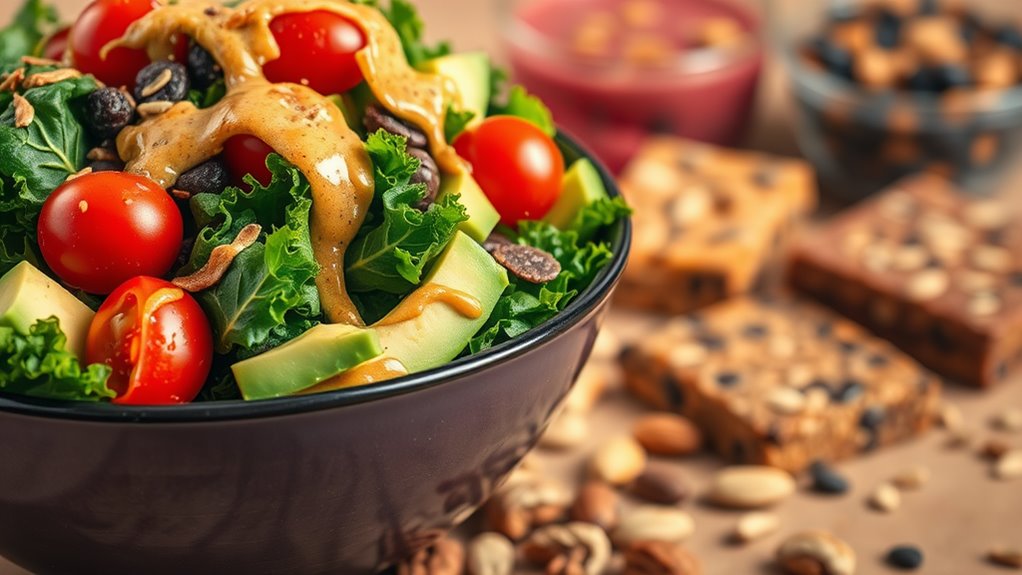Are You Eating ‘Healthy’ Foods That Keep You Fat.
You might think you’re making healthy choices by reaching for smoothies or granola bars, but these foods can be deceptive. Packed with added sugars and processed ingredients, they often sabotage your weight loss efforts. The reality is that many so-called “healthy” options can lead to unwanted weight gain. Understanding the hidden pitfalls in your diet is crucial if you want to truly nourish your body and achieve your goals. What should you look out for?
Key Takeaways
- Many foods labeled as “healthy,” like granola bars and smoothies, often contain high hidden sugars and calories that can lead to weight gain.
- Low-fat products might seem beneficial but often have added sugars and artificial ingredients that can increase calorie intake and promote overeating.
- Processed snacks, even if marketed as healthy, are often calorie-dense and nutrient-poor, contributing to excess calorie consumption.
- Emotional eating can lead to poor food choices, causing individuals to opt for seemingly healthy options that are calorie-rich.
- Portion sizes of healthy snacks are often smaller than perceived, leading to unintentional overeating and weight gain.
Understanding Healthy Food Myths
Have you ever wondered why some foods labeled as “healthy” might actually contribute to weight gain?
Many foods that pretend to be healthy are often high in sugar, unhealthy fats, or calories, misleading you into believing they’re good choices.
For instance, smoothies and salad dressings may contain hidden sugars or fats that add up quickly.
Even whole grain products can be deceiving; they might still pack in calories and preservatives.
Understanding these myths is crucial for making informed choices. Reading labels is essential to avoid falling for these so-called healthy options that can derail your weight management goals. Always read labels and consider portion sizes to avoid falling for these so-called healthy options that can derail your weight management goals.
The Truth About Granola and Energy Bars
What makes granola and energy bars seem like the perfect snack option?
Their convenience and marketing as “healthy” foods can be misleading.
Here’s what you should know:
- High Sugar Content: Many bars contain added sugars that spike insulin levels.
- Caloric Density: They can be calorie-dense, leading to weight gain if consumed excessively.
- Portion Sizes: Often, a single serving size is smaller than you think.
- Processing: Many are heavily processed, stripping away natural nutrients.
Additionally, be aware that some bars may have more sugar than candy bars which can undermine healthy eating intentions.
Before reaching for that granola bar, consider these factors.
You might be unwittingly adding more calories than you think.
Why Smoothies Can Be Calorie Bombs
When you make smoothies, it’s easy to overlook hidden sources of sugar, which can significantly boost the calorie count. You might also be surprised by how quickly portion sizes can add up, turning what seems like a healthy drink into a calorie bomb. Plus, the quality of ingredients you choose can impact not just the nutritional value but also the overall calorie content. For instance, using whole fruits instead of fruit juices can help keep sugar levels in check while maintaining a nutrient-dense drink.
Hidden Sugar Sources
Ever wondered why your seemingly healthy smoothie can pack a surprising calorie punch? Hidden sugars might be the culprit. Many popular ingredients can contribute to excessive calories and sugar intake:
- Flavored Yogurt: Often loaded with added sugars, making your smoothie sweeter than you think.
- Fruit Juices: Even 100% juice can have high sugar content, overshadowing the benefits of whole fruits.
- Sweetened Nut Milks: Many brands add sugars to enhance taste, adding unnecessary calories.
- Protein Powders: Some contain sweeteners that can spike sugar levels.
Stay vigilant about these hidden sugar sources to maintain a truly healthy diet!
Portion Sizes Matter
Portion sizes play a crucial role in determining whether your smoothie is a nutritious treat or a calorie bomb. Even healthy ingredients can pile on calories if you’re not careful. Here’s a quick breakdown of common smoothie components:
| Ingredient | Typical Serving Size | Calories |
|---|---|---|
| Spinach | 1 cup | 7 |
| Banana | 1 medium | 105 |
| Almond milk | 1 cup | 30 |
| Peanut butter | 2 tablespoons | 190 |
| Greek yogurt | 1 cup | 100 |
Mind your portions to keep your smoothie healthy!
Ingredient Quality Issues
How can seemingly healthy ingredients turn your smoothie into a calorie bomb?
It’s all about ingredient quality.
Many smoothies pack in hidden calories that can sabotage your diet.
Here are four culprits to watch out for:
-
Added Sugars: Sweeteners like honey and agave can quickly inflate calorie counts.
-
Full-Fat Dairy: Creamy yogurts or milk add richness but also extra calories.
-
Nut Butters: While nutritious, they’re calorie-dense and easy to overuse.
-
High-Calorie Add-Ins: Ingredients like granola or protein powders can sneak in excess calories.
Being mindful of these can help you make smarter smoothie choices.
The Hidden Dangers of Low-Fat and Fat-Free Products
What if the very products marketed as healthy options are actually sabotaging your diet?
Low-fat and fat-free foods often contain added sugars and artificial ingredients to enhance flavor, which can lead to overeating.
Research shows that these replacements can confuse your body’s natural hunger cues, making you crave more calories.
Additionally, removing fat can strip away essential nutrients and healthy fatty acids necessary for overall health.
While you may think you’re making a wise choice, these products can contribute to weight gain and nutritional deficiencies.
It’s crucial to scrutinize labels and choose whole, nutrient-dense foods instead. The perception of saving calories can be misleading due to these hidden pitfalls.
Misleading Labels: What to Look For
When you’re shopping for food, it’s crucial to understand nutritional claims on labels, as they can often be misleading. Look out for hidden ingredients like added sugars and unhealthy fats that might counteract the benefits of what seems like a healthy option. For instance, many granola bars can have high sugar content comparable to candy bars, so it’s essential to read labels carefully.
Understanding Nutritional Claims
Have you ever noticed how some food labels tout health benefits while hiding less desirable ingredients?
Understanding nutritional claims can help you make better choices.
Here are four common misleading statements to watch for:
- Low-Fat: Products may compensate with added sugars.
- All-Natural: This term isn’t regulated; it can still contain additives.
- Gluten-Free: Not inherently healthier; check for added calories.
- Fortified: Just because it’s enriched doesn’t mean it’s nutritious overall.
Hidden Ingredients to Avoid
Even with a solid understanding of nutritional claims, it’s important to scrutinize hidden ingredients that can undermine your health goals.
Watch out for added sugars, often disguised under names like high fructose corn syrup or agave nectar.
Additionally, trans fats may appear as partially hydrogenated oils, which can increase your risk of heart disease.
Artificial sweeteners, while calorie-free, can disrupt gut health and promote cravings.
Lastly, be cautious of sodium-rich preservatives, which can lead to water retention and bloating.
Strategies for Making Healthier Choices
How can you navigate the often confusing landscape of healthy foods to make smarter choices?
Start with these strategies:
- Read Labels: Check for added sugars and unhealthy fats; you might be surprised by hidden ingredients.
- Portion Control: Even healthy foods can contribute to weight gain if you eat too much.
- Whole Foods: Focus on minimally processed items like fruits, vegetables, and grains for better nutrition.
- Plan Ahead: Prepare meals in advance to avoid grabbing unhealthy options when you’re hungry. Meal planning can serve as a roadmap(#) to ensure you stay on track with your healthy eating goals.
Implementing these techniques can empower you to make informed decisions that support your health goals.





